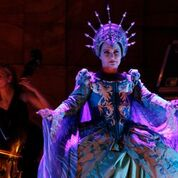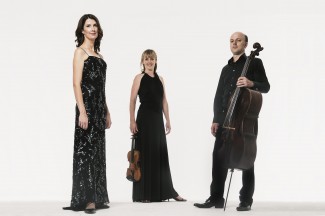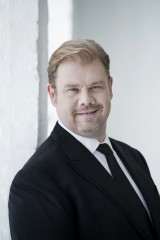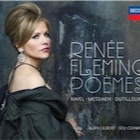Chamber Opera Review: Voyage To The Moon/ Musica Viva And Victorian Opera

Kudos to Michael Gow and Musica Viva with Victorian Opera for their creation Voyage to the Moon, a Baroque pastiche with libretto and direction by Gow, and a score constructed by the late Alan Curtis, complemented by Calvin Bowman after Curtis’ sudden death during the project.
The chamber opera opened in Sydney this week with a cast of three solo singers – soprano Emma Matthews as Orlando/Selena, mezzo-soprano Sally-Anne Russell as Astolfo and bass-baritone Jeremy Kleeman as Magus. A small ensemble of instrumentalists performing on period instruments was directed from the harpsichord by Phoebe Briggs.
Gow based his libretto on Ariosto’s epic poem Orlando Furioso, writing new words, in English, to recitatives and arias selected by Curtis. It is a simple story, dramatic and funny, with a compendium of sumptuous Baroque music beautifully performed in style, accompanied by well acted drama and a spritz of comedy.
Alan Curtis’ collection of 14 recitatives, arias, duets and trios and 3 orchestral works revived and introduced us to some brilliant pieces by Handel, de Majo, Molino, Gluck, Hasse, Telemann, Orlandini and Vivaldi. Apart from programming Handel’s Piangerò la sorte mia, (sung by the mezzo-soprano and not the soprano), the writers avoided familiar pieces. The musical narrative was fluent. Though disparate in source, the sequence of arias had continuity, peppered with contrast which added variety and gave direction to the drama.
Emma Matthews dazzled with her portrayal of Selena, showing off – in true Baroque style – her vocal range and pinpoint coloratura at full tilt without comprising accuracy or tone. Her first appearance as Orlando was demanding – calling on machismo rage and power at the very onset of the action. This settled into a more subdued and introspective portrayal at Orlando’s second appearance after she sings as Selena. Matthews’ Orlando was formidable, although she seemed more truly at home in both style and tessitura, inhabiting the character of Selena. Sally-Anne Russell was an impressive voice as Astolfo, with an equally impressive dramatic and comedic performance, extracting a healthy portion of laughs from the audience. It was a pleasure to hear emerging artist Jeremy Kleeman. He has a commanding presence on stage and a well modulated voice of great beauty – and he can do a stylish moon dance as well!
The band of Baroque musicians – violinists Rachel Beesley and Zoë Black, violist Simon Oswell, cellist Molly Kadarauch, double bassist Kirsty McCahon and oboist Emma Black – with Phoebe Briggs, performed splendidly, providing solid but sympathetic support for the singers as well as coming into their own for their three instrumental numbers. Emma Black gave an especially lyrical rendition of the slow movement from Telemann’s Concerto No 3 in G major (originally for oboe d’amore). In an integration of singers and instrumentalists, the band performed from the stage, placed behind the singers, with Matthews at one time weaving her way amidst the players.
Costume designer Christina Smith used the rich textures and colours of the Baroque to flesh out the characters, exquisitely dressing Orlando in suitably furious red, Astolfo in calming green, Magus in a mystical hooded cloak and Selena resplendent in an outfit that included elements of armour, a glittering corona, polonaise style skirt and a very long train.
Christina Smith also designed the pared down tongue- in- cheek stage set which met the various needs of a touring production, a recital hall venue and above all, fired the imagination, calling on observers to be drawn into the action, and conjure up their own fantasies from a minimally inhabited canvas; to understand and empathise with the characters. In this story espcially, it could have been tempting to recourse to dazzling pyrotechnics or over the top sets and accessories to be spoon-fed the story in graphic detail; the production entertained with subtle finesse whilst stoking creative thought.
Along with changes in lighting, the props on stage were recruited to complement the action, most amusingly when two music stands were commandeered to create an inter-planetary chariot that transported Astolfo and Magus to the moon.
The programme contained detailed historical notes and biographies. However, as the music and words were new to the audience, the performance would have been improved by having sur-titles projected above the stage or the libretto printed in the programme. Despite singing in English and even with the most impeccable diction, the text was hard to comprehend in places, more so when underlying a long melismatic or coloratura line and in the ensemble pieces when the three voices were singing simultaneously. This obscured the storyline in places. It was important to see the running order of the musical items printed in the programme, to know what we were hearing, although it was difficult to read in the darkened auditorium.
For fans of the Baroque this is an adventure with glorious music and performances to match that both entertained and encouraged thought.
Shamistha de Soysa for SoundsLikeSydney©
Click here for Michael Gow’s insights into the production.
Click here to watch a video trailer of Voyage to the Moon.
Voyage to the Moon is being performed at the City Recital Hall, Sydney on Saturday February 27 at 2 pm and then tours to Brisbane, Canberra, Perth and Adelaide.







